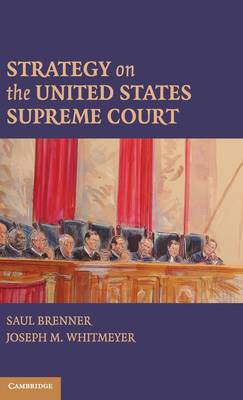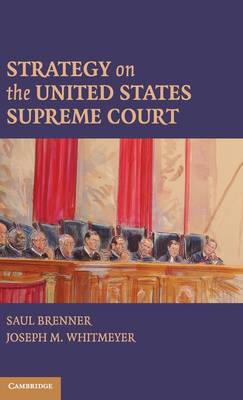
Door een staking bij bpost kan je online bestelling op dit moment iets langer onderweg zijn dan voorzien. Dringend iets nodig? Onze winkels ontvangen jou met open armen!
- Afhalen na 1 uur in een winkel met voorraad
- Gratis thuislevering in België vanaf € 30
- Ruim aanbod met 7 miljoen producten
Door een staking bij bpost kan je online bestelling op dit moment iets langer onderweg zijn dan voorzien. Dringend iets nodig? Onze winkels ontvangen jou met open armen!
- Afhalen na 1 uur in een winkel met voorraad
- Gratis thuislevering in België vanaf € 30
- Ruim aanbod met 7 miljoen producten
Zoeken
€ 82,45
+ 164 punten
Uitvoering
Omschrijving
To what extent do the justices on the Supreme Court behave strategically? In Strategy on the United States Supreme Court, Saul Brenner and Joseph M. Whitmeyer investigate the answers to this question and reveal that justices are substantially less strategic than many Supreme Court scholars believe. By examining the research to date on each of the justice's important activities, Brenner and Whitmeyer's work shows that the justices often do not cast their certiorari votes in accord with the outcome-prediction strategy, that the other members of the conference coalition bargain successfully with the majority opinion writer in less than 6 percent of the situations, and that most of the fluidity in voting on the Court is nonstrategic. This work is essential to understanding how strategic behavior - or its absence - influences the decisions of the Supreme Court and, as a result, American politics and society.
Specificaties
Betrokkenen
- Auteur(s):
- Uitgeverij:
Inhoud
- Aantal bladzijden:
- 208
- Taal:
- Engels
Eigenschappen
- Productcode (EAN):
- 9780521516723
- Verschijningsdatum:
- 16/02/2009
- Uitvoering:
- Hardcover
- Formaat:
- Genaaid
- Afmetingen:
- 142 mm x 216 mm
- Gewicht:
- 362 g

Alleen bij Standaard Boekhandel
+ 164 punten op je klantenkaart van Standaard Boekhandel
Beoordelingen
We publiceren alleen reviews die voldoen aan de voorwaarden voor reviews. Bekijk onze voorwaarden voor reviews.











